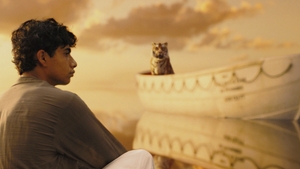 Editor’s note: GoSeeTalk is trying something new with this review of Ang Lee’s Life of Pi. Since there’s so much to enjoy Marc and Bill split up the review to focus on its two greatest strengths. Bill addresses the narrative structure/success of Life of Pi while Marc tackles praising its technical/visual achievements.
Editor’s note: GoSeeTalk is trying something new with this review of Ang Lee’s Life of Pi. Since there’s so much to enjoy Marc and Bill split up the review to focus on its two greatest strengths. Bill addresses the narrative structure/success of Life of Pi while Marc tackles praising its technical/visual achievements.
In Ang Lee’s latest film Life of Pi, an impressive adaptation of Yann Martel’s popular novel of the same name, a young man, Pi (Suraj Sharma), who survives a disaster at sea is hurtled into an epic journey of adventure and discovery. While cast away, he forms an unexpected connection with another survivor…a fearsome Bengal tiger. Though the premise of Life of Pi might sound simple it is anything but. This complex story has slightly heavy but downplayed themes about spirituality, religion, and hope that ring true whether you’re 9 or 90. Overall, Lee offers audiences a film that in execution, exposition and unparalleled visual composition, is a masterpiece in every sense of the word.
BILL: With inflating budgets and increased spectacle, the inane storylines of modern blockbusters have proliferated at an alarming pace. That’s why it’s so rare and such a pleasure to witness a film that manages to provide both wonderment and continued interest. You are taken for a journey, but here, the adventure and mystery doesn’t stop once the film ends. Life of Pi manages to give us a story that, despite the visuals, never confuses or disorientates. Simple, streamlined, and straightforward, this is the illusive case when a film can have depth yet be simple enough to understand for younger children.
MARC: Brilliant, lush, and vibrant storytelling abound in this adaptation of Life of Pi. On par with a Tarsem Singh level of breathtaking beauty its spectacular visuals it will elicit countless breathless oohs and ahhs, but there’s also a weighty story/narrative that draws you in even 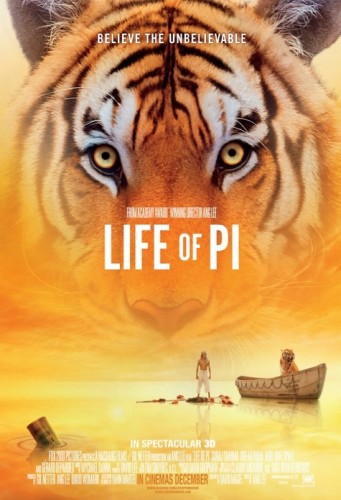 further. What Lee delivers in this heretofore thought unfilmable adaptation Martel’s novel is a wonderland of visuals but ones that helps drive the boat. And those visuals are very sophisticated. Whether it is the titular Pi and the tiger Richard Parker fighting the calamity of their oceanic adventure, or just two characters like the older Pi (Irrfan Khan) and interviewer (Rafe Spall) sitting across the table having dinner, even when nothing is happening, somehow it becomes some of the most beautiful frames you’ll ever see on screen.
further. What Lee delivers in this heretofore thought unfilmable adaptation Martel’s novel is a wonderland of visuals but ones that helps drive the boat. And those visuals are very sophisticated. Whether it is the titular Pi and the tiger Richard Parker fighting the calamity of their oceanic adventure, or just two characters like the older Pi (Irrfan Khan) and interviewer (Rafe Spall) sitting across the table having dinner, even when nothing is happening, somehow it becomes some of the most beautiful frames you’ll ever see on screen.
BILL: Perhaps it’s no coincidence that this film is rated PG. There’s the possibility that director Ang Lee and screenwriter David Magee chopped down the narrative of the beloved novel this film was adapted from to make it more accessible. Whatever they did, it simply works on the screen. There’s spirituality involved throughout, but it never submerges the film and you do not need to belong to any one faith or even a believer in a higher power to go along with it—after all, Pi doesn’t find himself beholden to any one religion or belief. There’s also outlandish elements to this survival story that follows Pi and his unwilling boat mate, the Bengal tiger who is humorously named Richard Parker, who are both lost at sea after a shipwreck, yet nothing is sacrificed. Miraculously, this rich film spends time setting up the minor players and does it all in a spare 127 minutes.
MARC: The film’s plucky mix of characters, cinematography, and music, at first, make this come off as a mix that falls somewhere between Jean-Pierre Jeunet’s Amélie and Tarsem Singh’s The Fall yet soon becomes its own film entirely. To the credit of Yann Martels novel the story is served with reverence even if it all still seems completely unbelievable. While conveying this story which is vastly interesting and, more importantly, a story worth telling, very very few times does the CG become apparent. For 99.8% of the film it is seamless. It becomes like a storybook that you just can’t help feel like a kid while watching. But saying that the imagery and cinematography are gorgeous is a gross understatement. Frankly, there just isn’t a word in the English language to properly describe the film. If a picture is worth a thousand words then the words necessary to appropriately describe this amazing adventure, though many critics may try, are simply incalculable.
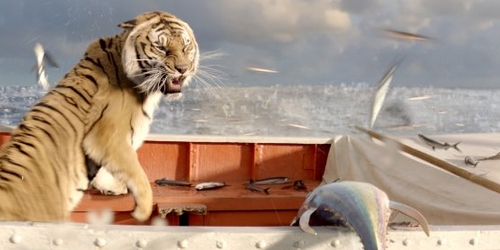
From lush jungles, to violent (or serene) ocean water, to trippy sea creatures it’s all remarkably beautiful. Not photo-realistic but better the visuals are photographic in which these highly defined elements have immense depth and screen presence. But of all the dazzling realism, nothing becomes as visceral as the headlining Tiger Richard Parker. It’s not possible that actor Suraj Sharma could be in the boat with the jungle cat but with so many times you’d swear he acted that life threateningly close to a real live the tiger. You’ll lose track of how many times you say WOW and duck when he claws at Pi in eye-popping 3D.
BILL: The film revolves around a now older Pi retelling his story to a young writer that is looking for inspiration. So, we know the ultimate outcome, and still the sojourn manages to create a stupefying awe. Sure, the narrative takes a while to get going, but once it becomes just Pi, the tiger, and the boat, we are shown the power that an elegant balance between character and visual flair can have. Lee uses a stroke of genius likely learned over his many years in the director’s chair by casting newcomer Suraj Sharma in the role of the shipwrecked Pi. With the blank slate of audiences having no preconceived notions, we are able to learn who Pi is as we learn who Sharma is as well.
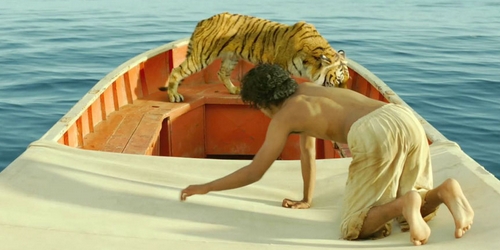
Pi and Parker grow to find a careful harmony, but it’s earned. There’s a drawn out adjustment period and one thing is always certain: both are wary of the other, at all times. Just when we start to feel at ease within this fantastical world, we are reminded of the natural circle of life in a sequence that actually elicited a collective gasp from the audience. Tigers are still tigers, after all. That might actually be a key scene to state, once and for all, that while the film is PG, there are few, if any, punches pulled. Instead, there is responsibility to the narrative and the audience. That’s a theme worthy of investing time in.
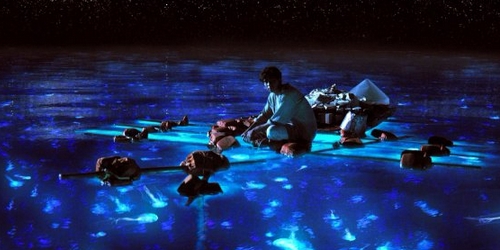
MARC: Life of Pi will help forever erase the lines between CG and practical effects and give us a truly put that magical feeling back in the theater going experience. You are going to want to see this on IMAX or not at all. You can find this, only shown in 3D, at any theater but for a story like this, bigger is most certainly better. It’s not that the story doesn’t work on the small screen, but like looking at a picture of the Grand Canyon and then seeing it in person, the trailers just can’t replicate the massive scale of the story or do the film justice. Lee’s Life of Pi is the kind of film that will continue to help change cinema forever. Plus that 3D is so gorgeous and so entirely immersive it really is like nothing you’ve seen before (thank you Arri Alexa and PACE Fusion 3-D!!). Further, if this is what filmmakers, granted well-financed filmmakers, are able to share with the world then there’s no limit as to what the future holds for cinema.
G-S-T RULING:
Life of Pi is artistic, and to some that might be the real draw, but its spectacular visuals go hand in hand with a wonderful and universal story yielding a film that will delight, impress, and warm hearts. It’s funny, charming, jaw-droppingly mystifying and further one ride you don’t want to get off. One of the most enjoyable experiences you’ll likely ever have in a cinema, Life of Pi will, at best change your life and at least alter your perception of what film/cinema is, can and should be. Not just for the benchmark visuals but the story about your place in the world, finding your purpose and getting in tune with the natural order of things. Movies like this don’t come along like this very often and as such, Life of Pi is like the Halley’s Comet of cinema. It’ll likely take you a week to wipe the smile off your face.
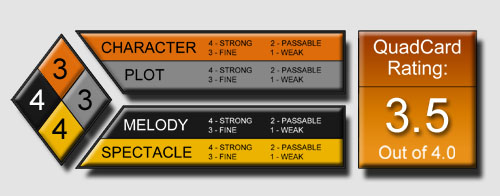
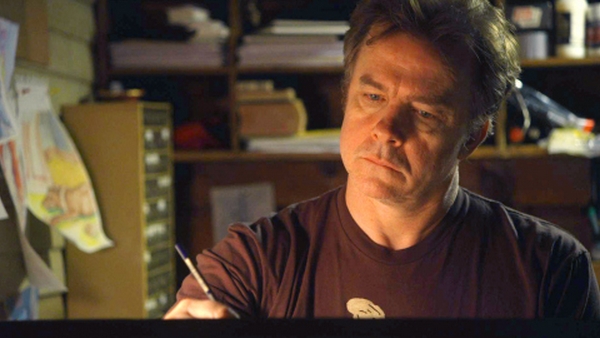


One Comment
Jessica Tomberlin
You two make a good team. 🙂 Can’t wait to see this!